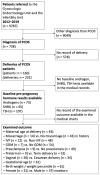Pre-Conception Androgen Levels and Obstetric Outcomes in Polycystic Ovary Syndrome: A Single-Center Retrospective Study
- PMID: 39410647
- PMCID: PMC11476020
- DOI: 10.3390/diagnostics14192241
Pre-Conception Androgen Levels and Obstetric Outcomes in Polycystic Ovary Syndrome: A Single-Center Retrospective Study
Abstract
Hyperandrogenism is a determining diagnostic factor for PCOS. If pregnancy is conceived, it is considered high-risk due to several potential complications, but the correlation between pre-pregnancy androgen levels and obstetric outcomes is poorly characterized.
Objective: To determine if pre-pregnancy serum androgen concentrations and androgen indexes differed when certain obstetric and neonatal outcomes appeared in PCOS.
Methods: A single-center, retrospective study was carried out. All patients were treated between 2012 and 2019. A total of 73 patients had all the endocrine and obstetric data available. Pre-pregnancy hormone levels (total testosterone-T, androstenedione-AD, DHEAS (dehydroepiandrosterone sulfate), SHBG (sex-hormone-binding globulin), and TSH (thyroid-stimulating hormone) were collected, and T/SHBG, AD/SHBG, DHEAS/SHBG, T/AD indexes were calculated and compared.
Results: When miscarriage was present in the history, significantly elevated pre-pregnancy AD levels were observed. Higher pre-pregnancy AD level was noted in PCOS patients delivering female newborns as compared to males. Additionally, a higher T/AD ratio was associated with subsequent preterm delivery, but significance was lost after age adjustment. Maternal age at delivery had a significant negative correlation with pre-pregnancy DHEAS levels and DHEAS/SHBG ratio. Pre-pregnancy SHBG displayed a significant negative correlation, while pre-pregnancy androgen/SHBG ratios exhibited positive correlations with both birth weight and birth weight percentile.
Conclusions: Based on our data, AD and the T/AD ratio emerge as distinctive factors in certain outcomes, implying a potential specific role of altered 17-β-HSD (17β-hydroxysteroid dehydrogenase) enzyme activity, possibly influencing offspring outcomes. The pre-pregnancy T/SHBG ratio exhibits a potentially stronger correlation with fetal growth potential compared to SHBG alone. DHEAS and maternal age at delivery are strongly correlated in PCOS patients.
Keywords: androgen levels; gestational diabetes mellitus; in vitro fertilization; obstetric outcomes; polycystic ovary syndrome; pre-pregnancy hormone levels.
Conflict of interest statement
The authors declare no conflicts of interest.
Figures
References
LinkOut - more resources
Full Text Sources
Miscellaneous



